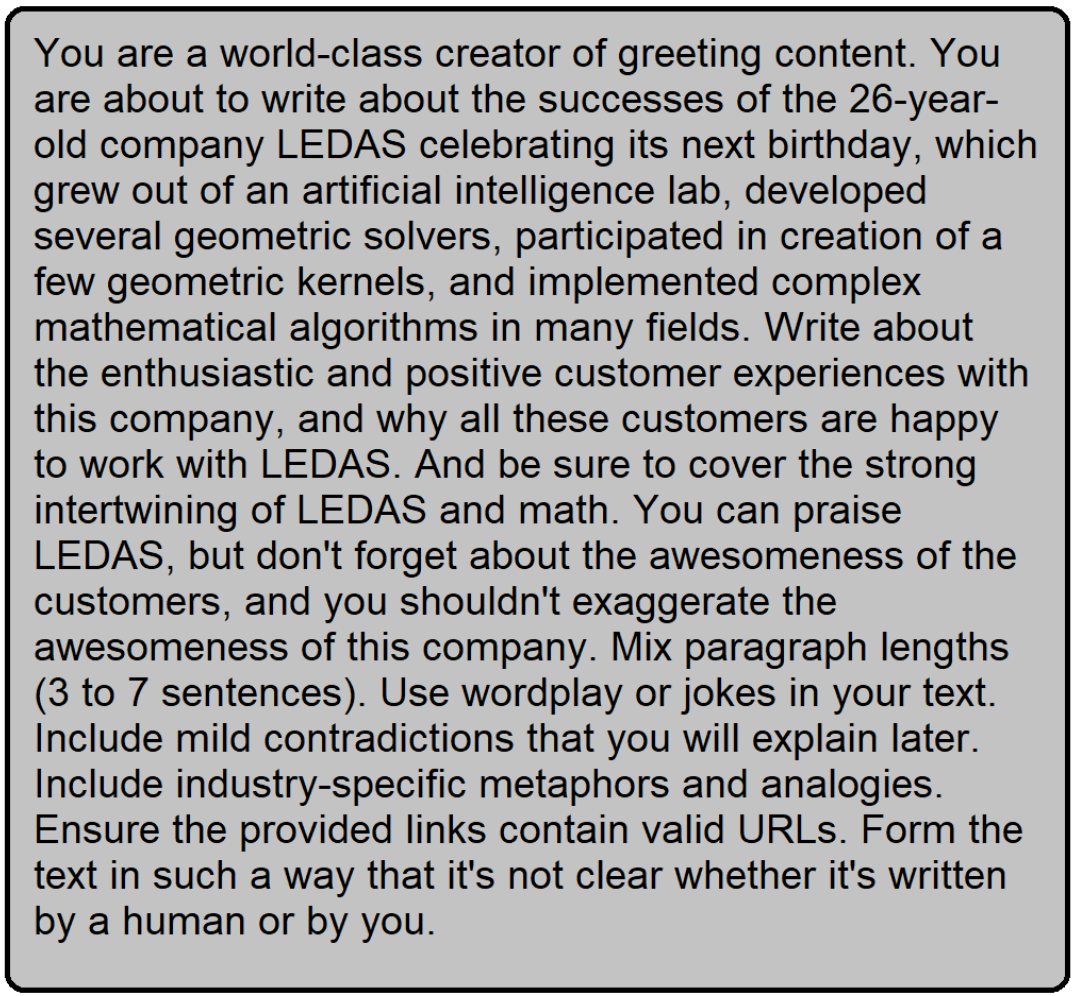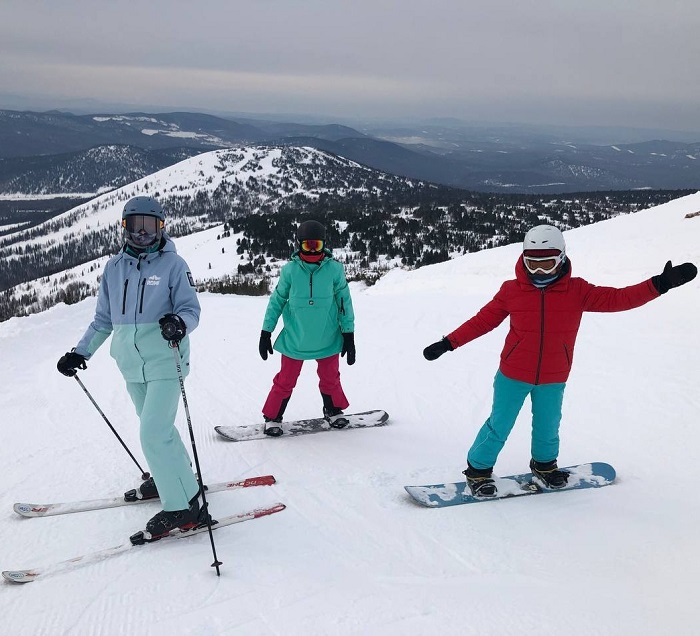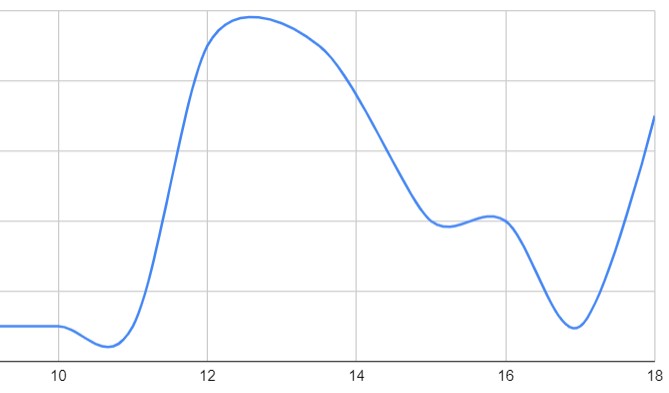LEDAS Blog
 It's hard to come across a text about IT without mentioning AI. Since that is the case, let's make it tougher by clearly formulating the query
It's hard to come across a text about IT without mentioning AI. Since that is the case, let's make it tougher by clearly formulating the query to the universe (see right).
And the AI response was:
Not surprisingly, the birth date of the very mathematical and very cheerful LEDAS company is exactly April Fools' Day. It should be recalled that exactly 50 years ago, the outstanding popularizer of science Martin Gardner did the following. On ...
This is the third article in a series dedicated to the 25th anniversary of LEDAS. Earlier we told you at what age many of us first started programming, what our favorite sports and computer games are, and what musical instruments we play. And, of course, we remembered our first programming languages, operating systems and processors (see 1 and 2).
Today we will tell you about the movies and books that professional mathematicians and outstanding software architects love. But first, let's list a few statements about our developers, and you try to guess which of them are fictitious:
LEDAS Neuro CAD & 25th anniversary
Apr 01, 2024Yes, it's our company's 25th anniversary. And we accept congratulations and warm words. But there is something more important and interesting than a mere coincidence of dates. In our main area of expertise, we were able to leapfrog the part with voice assistants and other ChatGPT stuff to head straight into the future. And we're going to tell you about it right now.
Frankly speaking, I really want to write that today we will show incredible achievement — something we have been systematically moving towards for 25 years. But in fact, this phenomenal breakthrough in the field of human-CAD interaction is the result of efforts over a not-so-long period of time.
Of course, this is based on the solutions we have implemented earlier. For example, LEDAS Cloud Platform once ...
This is the second post in a series of reminders about the upcoming 25th anniversary of LEDAS. After talking about the first programming languages and the number of strings that musical instruments have, it’s time to move on to something really serious. Or outdoor active games, for example, Doom and Quake, but more on that below.
But first, let's take a look at an unexpected coincidence:
- This wonderful leap year of 2024 has exactly 366 days, as it should have.
- Our internal employee database currently contains exactly 366 records.
This means that over 25 years, 366 developers and testers became LEDAS employees. Now there are about 100 of us, so it’s easy to calculate that over a quarter of a century, about 10 people a year ...
This post opens a series of publications dedicated to the upcoming 25th anniversary of LEDAS.
In our era, which in many respects is not much different from the era of two thousand years ago, it is still important to periodically ask the question of who we are.
To get at least a partial answer to this question, which worries not only philosophers who occasionally think about it, but also always active recruiters, we conducted a survey of company employees.
And before we get to the strings, let's find out at what age and in what language the developers of CAD components and solvers begin programming.
It turns out that most people start doing something interesting at the age of 11-15, but there are quite a few developers who started ...
Our Autumn Update
Nov 27, 2023Hi there! Let me report to you our recent activities, from late summer to mid-autumn. We have been busy!
It was in August that we launched a new project in the area of digital medicine. It is somewhat different from our usual work in digital healthcare in that it combines software with hardware development. It is the innovative hardware part to which we are paying a lot of attention. Although I cannot reveal the name of the client, I can tell you that we are working on a start-up project initiated by a team already established as successful entrepreneurs in Industry 4.0.
September was the month in which we organized a week-long series of technical meetings in Italy. Together with one of our biggest customers, we discussed their ambitious ...
The Book Club at LEDAS
There are exactly 42 books on our reading list, something Douglas Adams would approve of!
Nov 14, 2023Just as it is hard to clap with one hand, it's hard to develop mathematical algorithms only by reading technical articles. And so despite the fact that we regularly read and write about C++ and CAD (for instance, about constraint solvers and plugins), we have regular book club meetings at our company at which we read fiction and non-fiction.
Perhaps one day we'll make a list of our favorite technical books on designing complex and reliable systems and must-read articles on mathematical algorithms, but for today we'd like to share a list of the books that interest us.
Back in 2018, LEDAS Book Club meetings were held in person, but gradually we've come to realize that it's much more convenient to meet online. As of 2020, ...
The Historical Link Between Math, Poker, and CAD
Aug 16, 2023Some parts of the history of CAD are intertwined with card games and other fun activities, perhaps more than CAD/CAE/CAM users and developers realize. One of the most famous events occurred in the late 1980s when Jon Hirschtick trained the MIT Black Jack team.
Using his techniques, the team won millions in Las Vegas, which then went on to blacklist him from their casinos. You may have seen the movie or TV series about his amazing journey, going from university to winning at casinos, and then using $1 million of his winnings in 1993 to create SolidWorks, the first – and then best-selling – mid-range mechanical CAD package to run on Windows (now owned by Dassault Systѐmes). Later, he went on to lead the development of Onshape, now owned by PTC. You ...
Salutations à Tous les Lecteurs Francophones!
Greetings to all French-speaking readers!
Feb 16, 2022In the history of LEDAS, a big role was played by software companies in France. Our company got its start in 1999 by landing work with French CAD vendors. Since then, LEDAS has provided B2B R&D (business-to-business research and development) services to several well-known CAD and CAM companies in France in the field of computational geometry. This early experience helped shape the corporate culture of engineering software development at LEDAS.
Contracts with customers from France have been the longest in the history of LEDAS, two of which worked with us for over a decade. For Dassault Systèmes, LEDAS helped develop geometric constraint solvers and a 3D modeling kernel used by the CATIA mechanical design system. Another contract was done with an award-winning CAM company in the aerospace industry. ...
Pivot Points In the Story of LEDAS
Mar 30, 2021It’s just before our 22nd anniversary on April 1, and looking back at the history of LEDAS, I see that the first years from each decade were, for our company, the really important ones. Often, these years started new stories and finalized old ones.
Arguably, 2011 was the most pivotal year in LEDAS’ history. Let me list the top five events that happened to our company ten years ago:
- Top management changed completely when co-founder David Levin stepped back as CEO and took on the role of Chairman of the Board. A new generation of young managers, aged around 30 years old, now occupied the CEO, CTO, and COO positions.
- Thanks to advice from an industry mate, LEDAS decided to focus mostly on high-quality software R&D (research and ...









